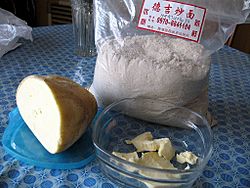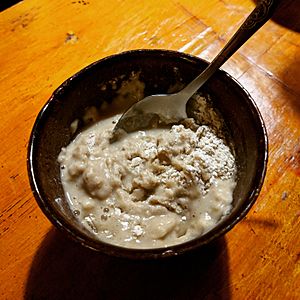Tsampa facts for kids
 |
|
| Alternative names | zamba |
|---|---|
| Type | Porridge |
| Place of origin | Tibet, Mongolia |
| Main ingredients | Flour (usually barley) |
Tsampa (pronounced "sam-pah") is a very important food in Tibet and the Himalayan mountains. It's a basic food, meaning people eat it a lot, almost every day. Tsampa is made from flour that has been roasted. This is usually barley flour, but sometimes wheat flour is used too. People often mix Tsampa with a special salty Tibetan butter tea. You can also find Tsampa in places like Turkestan and Mongolia, where it's called zamba.
Contents
How to Make Tsampa
Making Tsampa is quite easy because the flour is already roasted. This means you don't need to cook it! It's a quick and simple meal, perfect for people who are traveling. Many Tibetans, Sherpas, and nomads eat it on their journeys.
Mixing Tsampa
Traditionally, Tsampa is mixed with butter tea. But sometimes, people use water or even beer instead. You can also make Tsampa into a sweet porridge called "jham-thoo." This porridge is usually nutty and made with Tibetan cheese, butter, tea, and sugar. Another way to prepare Tsampa is as a soup called "tsam-thug." This soup is made with lamb or yak broth.
A Traveler's Tip
A traveler named André Migot once described how to eat Tsampa. He said you should leave a little buttered tea in your bowl. Then, you add a big scoop of Tsampa flour on top. You gently stir it with your finger, then knead it with your hand. As you do this, you turn your bowl around and around. Soon, you'll have a big, dumpling-like ball of Tsampa to eat. You can drink more tea with it. It takes some practice to get the right amount of Tsampa and tea. If you use too little tea, it might be dry. If you use too much, it might be too sticky. Sometimes, people add powdered milk, made from dried curds, to their Tsampa.
Tsampa's Cultural Importance

Tsampa is not just a food; it's a big part of Tibetan culture. People throw small pinches of Tsampa into the air during many Buddhist ceremonies. This tradition might even be older than Buddhism in the area. It was first used as an offering to nature spirits to ask for their protection. Later, it became a "mark of joy and celebration" in Buddhism.
Celebrations and Rituals
Today, throwing Tsampa is very common during New Year celebrations. People throw it while saying verses that wish good luck for themselves and others in the coming year. Tsampa throwing also happens at most Buddhist funerals. Here, it's meant to help release the soul of the person who has passed away.
Other Uses for Tsampa
Tsampa is used in other ways too. Sometimes, a paste of Tsampa and cumin is put on toothaches or sore spots. Tibetan athletes also know that Tsampa gives them quick energy. Because the flour is roasted, it's easy for the body to digest. This means the energy from Tsampa gets into the body very fast.
The importance of Tsampa in Tibetan culture is also shown in its name. "Tsampa" is the name of a special Tibetan typeface, which is a style of writing.
See also
 In Spanish: Tsampa para niños
In Spanish: Tsampa para niños


